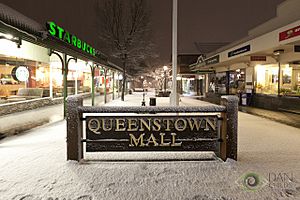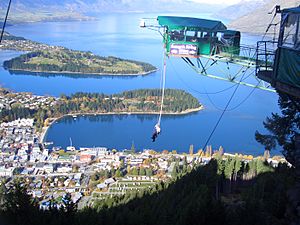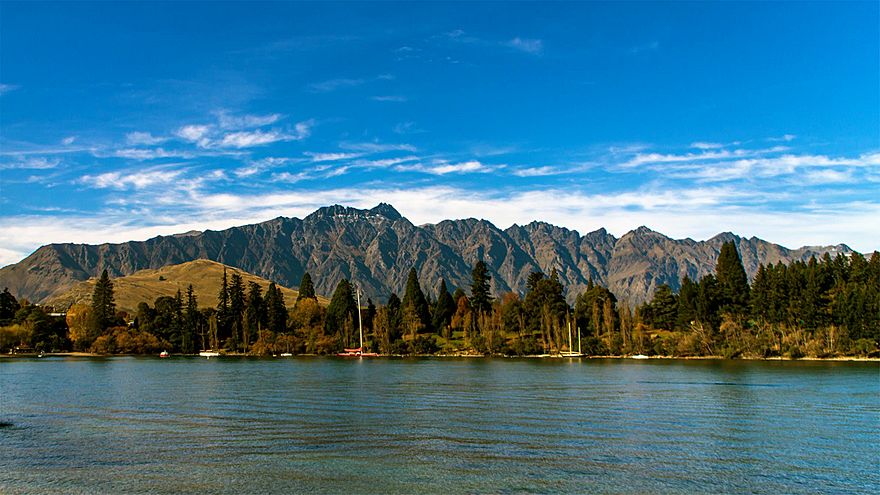Queenstown, New Zealand facts for kids
Quick facts for kids
Queenstown
Tāhuna (Māori)
|
|
|---|---|
|
Resort town
|
|
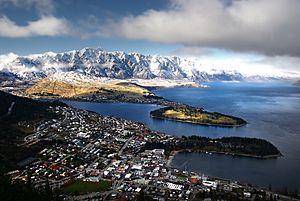
Queenstown from Bob's Peak
|
|
| Country | |
| Region | |
| Territorial authority | Queenstown-Lakes District |
| Named | January 1863 |
| Founded by | William Gilbert Rees |
| Area | |
| • Urban | 28.36 km2 (10.95 sq mi) |
| Population
(June 2023)
|
|
| • Urban | 29,000 |
| • Urban density | 1,023/km2 (2,650/sq mi) |
| • District | 52,800 |
| Time zone | UTC+12:00 (NZST) |
| • Summer (DST) | UTC+13:00 (NZDT) |
| Postcode(s) |
9300
|
| Area code(s) | 03 |
| Local iwi | Ngāi Tahu |
Queenstown (Māori: Tāhuna) is a resort town in Otago in the south-west of New Zealand's South Island. It has an urban population of 29,000 (June 2023).
The town is built around an inlet called Queenstown Bay on Lake Wakatipu, a long, thin, Z-shaped lake formed by glacial processes, and has views of nearby mountains such as The Remarkables, Cecil Peak, Walter Peak and just above the town, Ben Lomond and Queenstown Hill.
The Queenstown-Lakes District has a land area of 8,704.97 square kilometres (3,361.01 sq mi) not counting its inland lakes Hāwea, Wakatipu, and Wānaka. The region has an estimated resident population of 52,800 (June 2023). Neighbouring towns include Arrowtown, Glenorchy, Kingston, Wānaka, Alexandra, and Cromwell. The nearest cities are Dunedin and Invercargill. Queenstown is known for its commerce-oriented tourism, especially adventure and ski tourism.
Contents
History
Māori settlement and presence
The area was discovered and first settled by Māori before non-Māori arrived. The first non-Māori to see Lake Wakatipu was European Nathanael Chalmers who was guided by Reko, the chief of the Tuturau, over the Waimea Plains and up the Mataura River in September 1853. Evidence of stake nets, baskets for catching eels, spears and ashes indicated the Glenorchy area was visited by Māori. It is likely Ngāi Tahu Māori visited Queenstown en route to collect Pounamu (greenstone). There was a settlement called Te Kirikiri Pa occupied by the tribe of Kāti Mamoe which was situated in the location of the current Queenstown Gardens, but by the time European migrants arrived in the 1860s this settlement was no longer being used.
Subsequent European settlers
European explorers William Gilbert Rees and Nicholas von Tunzelmann were the first non-Maoris to settle the area. Rees established a high country farm in the location of Queenstown's current town centre in 1860, but the discovery of gold in the Arrow River in 1862 encouraged Rees to convert his wool shed into a hotel named the Queen's Arms, now known as Eichardt's. Many Queenstown streets bear names from the gold mining era (such as Camp Street) and some historic buildings remain. William's Cottage, the Lake Lodge of Ophir, Queenstown Police Station, and St Peter's Anglican Church lie close together in a designated historic precinct.
Naming
There are various apocryphal accounts of how the town of Queenstown was named however the following is the most likely:
When William Rees first arrived in the area and built the homestead the area was known as The Station although miners soon referred to it as The Camp from 1860 to 1862.
The miners and especially the Irish had taken an interest in the ceremony held for a small town called The Cove in Ireland which was renamed to Queenstown in honour of Queen Victoria in 1850. They may have had their own ceremony at the intersection of Rees and Beach Streets replicating some of the elements in the renaming of the Irish town.
Subsequent to this a public meeting was held for the purpose of naming the township on the lake in January 1863 (probably the weekend of the 3rd and 4th) in which the town was officially given the name of Queenstown in reference to Ireland's Queenstown. By 9 and 10 January 1863 the town was being reported with the name of Queenstown from several reports written by a correspondent in the Otago Witness on Monday the 5th and Tuesday the 6th. It was during the meeting there may have been a reference by a miner of the town being "fit for a Queen" (this is one of the most popular accounts of how the town was named).
The Māori name for Queenstown of Tāhuna means shallow bay.
Tourism
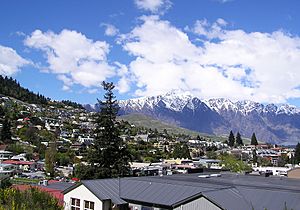
A resort town, Queenstown boasted 220 adventure tourism activities in 2012. Skiing and snowboarding, jet boating, whitewater rafting, bungy jumping, mountain biking, skateboarding, tramping, paragliding, sky diving and fly fishing are all popular.
Queenstown is a major centre for snow sports in New Zealand, with people from all over the country and many parts of the world travelling to ski at the four main mountain ski fields (Cardrona Alpine Resort, Coronet Peak, The Remarkables and Treble Cone). Cross country skiing is also available at the Waiorau Snowfarm, near Cardrona village.
The 100-year-old twin screw coal fired steamer TSS Earnslaw traverses Lake Wakatipu.
Queenstown lies close to the centre of a small wine producing region, reputed to be the world's southernmost. The Two Paddocks vineyard is owned by local actor Sam Neill. Neighbouring, historic Arrowtown features restaurants and bars.
Other tourist activities include:
- Ben Lomond, a nearby mountain for a view of the area
- The Skyline Gondola ascends Bob's Peak on Ben Lomond
- Kiwi Birdlife Park and Paradise for the paradise duck (Tadorna variegata)
- Walk, mountain bike, or run The Queenstown Trail
- Skippers Road
- Scenic flights
Culture
Festivals
Queenstown has many festivals. In 2013, examples include Bike Festival (March/April), Winter Festival (June), and Jazz Festival (October).
Locations for television and film
Jane Campion's six-part drama mystery Top of the Lake was shot during 2012 for pay TV release in 2013. The lakes of the Wakatipu appear ominous, and the Southern Alps spectacular. The main location is Moke Lake and scenes were shot on Lower Beach Street and Coronation Drive, and at a supermarket and bottle store on Shotover Street.
In 2010, Cycle 14 of America's Next Top Model, was, in part filmed in Queenstown. The cycle was won by Krista White. Raina Hein was runner up.
Queenstown and the surrounding area contains many locations used in the filming of the The Lord of the Rings film trilogy. Locations used include Paradise near Glenorchy, at the head of Lake Wakatipu.
Queenstown became popular in South Asia after the release of Bollywood Blockbuster Kaho Naa... Pyaar Hai which was partially shot there. Starring sensational debuts by Hrithik Roshan & Amisha Patel it was this film that opened the doors for both tourists and filmmakers from India to New Zealand with Queenstown being the most sought after destination. Queenstown featured for 17 minutes in I Hate Luv Storys, a 2010 Bollywood romantic comedy. Queenstown and the surrounding areas were also used in the 2009 X-Men Origins: Wolverine film. Mee-Shee: The Water Giant was shot in Queenstown in 2005, and released to DVD in the same year. Queenstown was also used to film most of the 1988 The Rescue. Queenstown was the base for filming the George Lucas 1988 fantasy film Willow.
Filming of the 1981 film Race for the Yankee Zephyr took place in and around Queenstown, the first major motion picture production for the area.
The first and last episodes of the fifth season of The Mole were filmed in Queenstown. In the latter episode, the final three contestants took the final computer quiz on the Kingston Flyer.
The 2017 Filipino drama film Northern Lights was shot entirely on location in Queenstown substituting for the setting of Alaska.
Sports and recreation
- Queenstown Events Centre and stadium
- Paragliding or Hang Gliding
- Aerobatics with the Wakatipu Aero Club at Queenstown Airport at Frankton
- Golf at Millbrook Resort, Jack's Point, or Queenstown Golf Club
- Disc golf at the Queenstown Gardens
- Tennis at the Queenstown Tennis Club in Queenstown Gardens
- Cricket at the Queenstown Cricket Club
- Netball at the Wakatipu Netball Centre
- Rugby league and Rugby union at the Wakatipu Rugby League Club Memorial Park
- Touch rugby during the summer season
- Scuba diving or snorkeling in a river, bridge wreck, or in Lake Wakatipu
- Adventure sport, canyon-swing, parachute, jetboat, bungy jump, river-surf, or kitesurf
In the area
- Central Otago region
- Central Otago wine region
- History of the Central Otago Gold Rush
- Milford Road, Milford Sound / Homer Tunnel, the Fiordland Lakes / Doubtful Sound
- Tramping track near Glenorchy
- Routeburn, one of the New Zealand Great Walks
Geography
Queenstown is situated on the shore line of Lake Wakatipu, the third largest lake by surface area in New Zealand. It is at a relatively low altitude for a ski and snowboarding centre at 310 metres above sea level on the shores of the lake, but nestled among mountains. There are close-by gorges and some plains suitable for agriculture.
Climate
Because of its relatively moderate altitude (310 metres) but with high mountain surroundings, it has an oceanic climate (Köppen climate classification Cfb). Summer has long warm days with temperatures that can reach 30 °C while winters are cold with temperatures often in single digits with frequent snowfall, although there is no permanent snow cover during the year. As with the rest of Central Otago, Queenstown lies within the rain shadow of the Southern Alps, but being closer to the west coast the town is more susceptible to rain-bearing fronts compared to nearby Cromwell, Wanaka and Alexandra. The hottest recorded temperature in Queenstown is 34.1 °C (93 °F), while the coldest is −8.4 °C (17 °F).
| Climate data for Queenstown (1981–2010) | |||||||||||||
|---|---|---|---|---|---|---|---|---|---|---|---|---|---|
| Month | Jan | Feb | Mar | Apr | May | Jun | Jul | Aug | Sep | Oct | Nov | Dec | Year |
| Average high °C (°F) | 21.8 (71.2) |
21.8 (71.2) |
18.8 (65.8) |
15.0 (59.0) |
11.7 (53.1) |
8.4 (47.1) |
7.8 (46.0) |
9.8 (49.6) |
12.9 (55.2) |
15.3 (59.5) |
17.1 (62.8) |
19.7 (67.5) |
15.0 (59.0) |
| Daily mean °C (°F) | 15.8 (60.4) |
15.6 (60.1) |
13.0 (55.4) |
9.7 (49.5) |
7.0 (44.6) |
4.1 (39.4) |
3.0 (37.4) |
5.0 (41.0) |
7.7 (45.9) |
9.8 (49.6) |
11.6 (52.9) |
14.0 (57.2) |
9.7 (49.5) |
| Average low °C (°F) | 9.8 (49.6) |
9.4 (48.9) |
7.2 (45.0) |
4.3 (39.7) |
2.3 (36.1) |
−0.3 (31.5) |
−1.7 (28.9) |
0.2 (32.4) |
2.5 (36.5) |
4.3 (39.7) |
6.0 (42.8) |
8.3 (46.9) |
4.4 (39.9) |
| Average precipitation mm (inches) | 64.7 (2.55) |
50.3 (1.98) |
53.4 (2.10) |
56.2 (2.21) |
68.5 (2.70) |
71.5 (2.81) |
50.3 (1.98) |
66.2 (2.61) |
62.4 (2.46) |
66.4 (2.61) |
63.6 (2.50) |
75.3 (2.96) |
748.9 (29.48) |
| Average precipitation days (≥ 1.0 mm) | 7.2 | 6.2 | 7.4 | 7.4 | 9.0 | 9.2 | 6.9 | 9.1 | 8.5 | 8.8 | 7.6 | 9.6 | 96.9 |
| Average relative humidity (%) | 70.2 | 74.3 | 75.8 | 78.4 | 81.1 | 83.8 | 83.3 | 80.5 | 73.1 | 70.9 | 67.5 | 69.4 | 75.7 |
| Mean monthly sunshine hours | 230.3 | 207.3 | 187.0 | 145.4 | 87.8 | 71.8 | 88.3 | 120.0 | 153.6 | 197.7 | 216.6 | 223.5 | 1,929.2 |
| Source: NIWA Climate Data | |||||||||||||
Infrastructure
Transport
Queenstown is accessible by road and air but not by rail (similar to Kaitaia, Taupo and Nelson).
As a resort centre, many bus services operate into Queenstown, mostly for package tours, but daily services for locals and others are available to and from Invercargill, Dunedin and Christchurch, the main cities closest to Queenstown. Bee Cards are to replace GoCards on local buses on 15 September 2020.
Queenstown Airport takes flights from Australia by airlines Air New Zealand, Qantas, Virgin Australia and Jetstar and has destinations that include Brisbane, Gold Coast, Melbourne and Sydney (the frequency is much increased over the ski season and during summer). Domestic flights fly to Auckland, Christchurch and Wellington. Queenstown Airport is New Zealand's busiest helicopter base, also the fourth-busiest airport by passenger traffic, and is also heavily used for tourist 'flightseeing', especially to Milford Sound / Piopiotahi and Aoraki / Mount Cook, using both fixed-wing and rotary-wing aircraft.
The primary road access to the Queenstown area is via State Highway 6 (SH6), from Cromwell through the Kawarau Gorge to Frankton, where a 9 km spur (SH6A) leads to the CBD and connects with the Glenorchy Road. SH6 continues south, crossing the Kawarau river before heading down the eastern side of Lake Wakatipu to Kingston before crossing the provincial boundary and emerging on the plains of Southland, terminating in the city of Invercargill. A difficult road over the Crown Range leads to Cardrona skifield and Wānaka, and is New Zealand's highest paved public road pass.
Queenstown is the departure point for a large number of bus day trips to Milford Sound, which entails a return trip of approximately 12 hours. There are scenic flights available to and from Milford Sound. A return flight, including a two-hour cruise, is approximately four hours.
Utilities
Electricity distribution in Queenstown is the responsibility of two companies, Dunedin-based Aurora Energy and Invercargill-based Powernet. Electricity is supplied from Transpower's national grid at its substation in Frankton, which in turn is fed by a twin-circuit 110,000-volt line from Transpower's Cromwell substation.
Queenstown was one of the last towns in New Zealand with a manual telephone exchange, whereby all calls had to be connected by an operator. The town was upgraded to a fully automatic exchange in 1988. Fibre to the premises was rolled-out in Queenstown as part of the Fifth National Government's Ultra-Fast Broadband programme, with the rollout completed in July 2016.
Suburbs and nearby areas
Residential housing in the Queenstown area is quite expensive due to factors such as the town being a tourist destination, its lack of land and its desirability to foreigner and investors. Queenstown is rated the second highest average cost per property in New Zealand with only Auckland being higher as of 2016.
Central Queenstown contains many businesses, apartments and homes but is near many suburbs or large areas of housing which are: Fernhill, Sunshine Bay, Queenstown Hill, Goldfield Heights, Marina Heights, Kelvin Heights, Arthurs Point and Frankton. Just outside Queenstown are the areas of: Arrowtown, Closeburn, Dalefield, Gibbston, Jack's Point, Hayes Creek, Lake Hayes Estate, Shotover Country and Quail Rise.
Sister cities
Economy
Growth and affordability
Residential housing in the Queenstown area is expensive due to factors such as the town being a tourist destination, its lack of land and its desirability to foreigners and investors. Queenstown is rated the least affordable place in New Zealand to buy a property, overtaking Auckland at the start of 2017. In December 2016 the average house price in the Queenstown area rose to $1 million NZD.
Employment
The area’s growth rate is one of the fastest in the country with the population growing 7.1% from 2015 to 2016 in a 12-month period. Most jobs in Queenstown are tourism- or accommodation-related. Employment growth was also the highest of any area in New Zealand at 10.3% in the March 2016 year.
Retail
Queenstown has a tourist-focused shopping area, centred around the Queenstown Mall. The public pedestrian street opened in 1990, and includes Reading Cinemas.
O'Connells Shopping Centre also opened in 1990, and is due to undergo an upgrade in 2021.
In 1986, Queenstown was granted an exemption to allow shops to open every day of the year except Christmas Day, Easter Sunday and before 12 noon on Anzac Day (at the time, shops in New Zealand were required to close on Sundays and public holidays). The exemption was extended in 1990 allow shops to open on Easter Sunday. The exemption applies to all shops in a 35-kilometre (22 mi) radius of the intersection of Camp Street and Ballarat Street in central Queenstown, and makes Queenstown and the Lake Wakatipu basin one of only three areas in New Zealand where shops may open on Good Friday (the other two are Picton and Paihia).
Demography
Queenstown is described by Statistics New Zealand as a medium urban area with an area of 28.36 km2 (10.95 sq mi). It had an urban population of 29,000 (June 2023), making it the 35th-largest urban area in New Zealand. In 2016, Queenstown overtook Oamaru to become the second-largest urban area in Otago, behind Dunedin. The Queenstown urban area as defined by Statistics New Zealand doesn't include Lake Hayes or Arthurs Point, which are contiguous with Queenstown but are designated as separate urban areas. The combined population of the three urban areas is Expression error: Missing operand for +..
| Historical population | ||
|---|---|---|
| Year | Pop. | ±% p.a. |
| 2006 | 10,428 | — |
| 2013 | 11,334 | +1.20% |
| 2018 | 13,539 | +3.62% |
The Queenstown urban area had a population of 13,539 at the 2018 New Zealand census, an increase of 2,205 people (19.5%) since the 2013 census, and an increase of 3,111 people (29.8%) since the 2006 census. There were 4,254 households. There were 7,089 males and 6,447 females, giving a sex ratio of 1.1 males per female, with 1,341 people (9.9%) aged under 15 years, 4,887 (36.1%) aged 15 to 29, 6,264 (46.3%) aged 30 to 64, and 1,041 (7.7%) aged 65 or older.
Ethnicities were 71.2% European/Pākehā, 4.5% Māori, 1.2% Pacific peoples, 17.8% Asian, and 10.5% other ethnicities (totals add to more than 100% since people could identify with multiple ethnicities).
The proportion of people born overseas was 58.3%, compared with 27.1% nationally.
Although some people objected to giving their religion, 58.5% had no religion, 29.1% were Christian, 2.8% were Hindu, 0.6% were Muslim, 1.7% were Buddhist and 3.4% had other religions.
Of those at least 15 years old, 3,234 (26.5%) people had a bachelor or higher degree, and 759 (6.2%) people had no formal qualifications. 1,692 people (13.9%) earned over $70,000 compared to 17.2% nationally. The employment status of those at least 15 was that 9,165 (75.1%) people were employed full-time, 1,263 (10.4%) were part-time, and 138 (1.1%) were unemployed.
| Name | Area (km2) | Population | Density (per km2) | Households | Median age | Median income |
|---|---|---|---|---|---|---|
| Frankton | 7.62 | 2,895 | 380 | 1,017 | 32.8 years | $39,300 |
| Frankton Arm | 1.20 | 1,917 | 1,598 | 603 | 31.2 years | $41,200 |
| Kelvin Heights | 9.28 | 1,170 | 126 | 447 | 43.4 years | $44,800 |
| Queenstown Central | 0.81 | 1,017 | 1,256 | 261 | 30.0 years | $34,300 |
| Quail Rise | 6.27 | 708 | 113 | 234 | 40.5 years | $49,200 |
| Queenstown East | 0.98 | 1,416 | 1,445 | 441 | 30.5 years | $38,800 |
| Sunshine Bay-Fernhill | 1.31 | 2,931 | 2,237 | 861 | 29.6 years | $37,600 |
| Warren Park | 0.94 | 1,485 | 1,580 | 390 | 28.7 years | $34,200 |
| New Zealand | 37.4 years | $31,800 |
Education
Primary schools
Queenstown Primary School is a co-educational state primary school for Year 1 to 8 students, with a roll of 612 as of April 2023.
St Joseph's School is a co-educational Catholic state-integrated primary school for Year 1 to 8 students, with a roll of 132.
There are also two primary schools in Frankton and a school in Shotover Country.
Secondary schools
Wakatipu High School, a state secondary school for Year 9 to 13 students, is located in Frankton.
Tertiary education
Southern Institute of Technology (SIT), based in Invercargill, has a campus in Queenstown.
Queenstown Resort College is a tertiary education provider focussing on tourism. The college actively supports events for international travel agents.
ACE Wakatipu has a community focus, and provides links to many adult training opportunities.
Notable people
- Sam Neill (born 1947), actor, has a home in Queenstown
- Tim Bevan (born 1957), film producer, was born in Queenstown
- Jaime Passier-Armstrong (born 1981), actress, was born in Queenstown
- Jane Taylor, lawyer and current Chair of New Zealand Post, lives in Queenstown
- Kim Dotcom, internet entrepreneur
Images for kids
See also
 In Spanish: Queenstown (Nueva Zelanda) para niños
In Spanish: Queenstown (Nueva Zelanda) para niños


